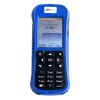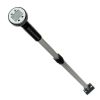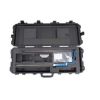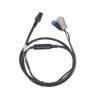SonTek FlowTracker2 Handheld ADV
Features
- Improved ADV acoustics: faster pinging, lower noise and better standard error
- Embedded GPS for geo-referencing with automatic or manual fixes
- Set up and save templates—no need to re-enter data every time you visit a site
- Expedited repair and warranty service
- Lifetime technical support
- More
Overview
The SonTek FlowTracker2 (FT2) handheld Acoustic Doppler Velocimeter (ADV) is a wading discharge measurement instrument that is handheld, portable and precise. 2-D data in the horizontal plane (2D/3D option available) allows the most comprehensive QC and understanding about flow conditions. User calibration is never required.
Benefits
- Embedded GPS for georeferencing with automatic or manual fixes
- Improved ADV acoustics: faster pinging, lower noise and better standard error
- Battery life icon on the screen at all times. Pre-load the spare cartridge and replace, even mid-measurement, with no data loss
- Detachable probe with extension cables to customize cable length up to 10m
- Probes and handhelds are interchangeable—flexibility within agency teams and when sending equipment for service
- Set up and save templates—no need to re-enter data every time you visit a site
- Bluetooth or direct USB interface with PC
- Audio prompts
Handheld Specifications
| Input Battery Voltage | 8 - 12 VDC |
| Power Supply | 8 X AA Batteries |
| Battery Life | 11 hours continuous use, typical settings1 |
| Power Consumption | 1 W (Average) |
| GPS: H. Position Accuracy | Up to 2.5 m (8.2 ft) nominal2 |
| GPS: Frequency | L1 (1.575 MHz) SBAS compensation (WAAS, EGNOS, MSAS, GAGAN) |
| LCD Resolution | 320 X 240 TFT Transmissive |
| Bluetooth | Class 2, Range = 10 m (33 ft) nominal |
| USB | Micro USB, IP-67 |
| Battery Power to Probe | 8 - 12 VDC |
| Data Transfer | RS-232 |
| Data Storage | 16 GB. Up to 10k discharge measurements Up to 10 million velocity samples |
| Operating Temperature | Alkaline Batteries: -20° to 45°C (-4°F to 113°F) NiMH: -20° to 50°C (-4°F to 122°F) |
| Storage Temperature | -30° to 70° C (-22° F to 158° F)3 |
| Waterproof Rating | IP-67 (1m submersible) |
| Handheld Dimensions | (L)10.4 cm (4.1 in) (W) 6.4 cm (2.5 in) (H) 23.7cm (9.3 in) |
| Weight in Air | 0.75 kg (1.65 lbs) |
| Weight in Water | -0.25 kg (-0.55 lbs) |
Probe Specifications
| Velocity Range | ±0.001 to 4.0 m/s (0.003 to 13 ft/s) |
| Velocity Resolution | 0.0001 m/s (0.0003 ft/s) |
| Velocity Accuracy | +/1% of measured velocity, +/- 0.25cm/s |
| Acoustic Frequency | 10.0 MHz |
| Sampling Volume Location | 10 cm (3.93 in) from the center transducer |
| Minimum Depth | 0.02 m (0.79 in) |
| Depth Measurement Range | 0 to 10m (0 to 32.81ft) |
| Depth Measurement Resolution | 0.001m (0.003ft) |
| Depth Sensor Accuracy | +/- 0.1% of FS (temperature compensated over full operating range) |
| +/- 0.05% Static (steady-state at 25°C) | |
| Additionally compensated for real-time water velocity, temperature, salinity, and altitude. |
|
| Temperature Sensor | Resolution: 0.01° C, Accuracy: 0.1° C |
| Tilt Sensor | Resolution: 0.001°, Accuracy: 1.0° |
| Communication Protocol | RS-232 |
| Operating/Storage Temperature | -20° C to 50° C (-4° F to 122° F) |
| Probe Head Dimensions | (L)13.3 cm (5.22 in) (W) 6.1 cm (2.39 in) (H) 2.3 cm (0.90 in) |
| Standard Cable Length | 1.5 m (4.92 ft) |
| Weight in Air | 0.90 kg (1.98 lbs) |
| Weight in Water | 0.30 kg (0.66 lbs) |
- (1) FlowTracker2 handheld display unit
- (1) USB interface cable
- (1) Spare battery cartridge
- (8) AA alkaline batteries
- (1) Shipping case
In The News
From Paddles to Phytoplankton: Studying Vermont’s Wildest Lakes
For six months of the year, Rachel Cray, a third-year PhD student at the Vermont Limnology Laboratory at the University of Vermont, lives between a microscope and her laptop, running data. For the other six months, she is hiking and canoeing four of Vermont’s lakes, collecting bi-weekly water samples. Cray studies algal phenology across four lakes in Vermont, US, that have low anthropogenic stress—or in other words, are very remote. Funded by the National Science Foundation Career Award to Dr. Mindy Morales, the lakes Cray researches part of the Vermont Sentinel Lakes Program, which studies 13 lakes in the area and, in turn, feeds into the Regional Monitoring Network, which operates in the Northeast and Midwest US.
Read MoreReimagining Water Filtration: How Monitoring and Science Enhance FloWater Filtration Systems
Over 50% of Americans think their tap water is unsafe , according to the Environmental Working Group (EWG). Other recent surveys have found that number to be as high as 70% of persons surveyed. Whether due to increased public awareness of water quality issues or confusion about how municipal water sources are regulated, there is a clear distrust of tap water in the United States. According to industry expert Rich Razgaitis, CEO and co-founder of the water purification company FloWater, this issue creates a damaging cycle. Razgaitis explained that the health and environmental problems associated with contaminated water aren’t the only issues. As people become increasingly aware that some tap water is unsafe, they resort to bottled water.
Read MoreMonitoring New Hampshire’s Aquatic Ecosystems: Continuous Data Collection in the Lamprey River Watershed
New Hampshire’s aquatic ecosystems provide a range of ecosystem services to the state and region. Resources and services like clean water, carbon storage, climate regulation, nutrient regulation, and opportunities for recreation all depend on New Hampshire’s aquatic ecosystems remaining healthy. Jody Potter, an analytical instrumentation scientist at the University of New Hampshire (UNH), is studying these aquatic ecosystems in hopes of developing an improved understanding of ecosystem services and their interactions with climate change, climate variability, and land use changes. [caption id="attachment_39799" align="alignnone" width="940"] Aquatic sensors in the Merrimack River in Bedford, NH, with I-293 in the background.
Read More

















